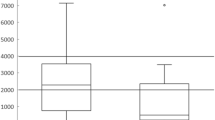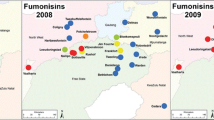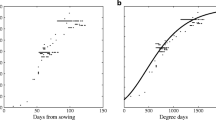Abstract
Maize fumonisin (FB) contamination is strongly driven by the weather conditions and crop resistance. Logistic regression techniques were used to quantify the effect of weather-based variables on total FB content in kernel samples coming from many locations of the Argentinean Pampas region (over three growing seasons), and collected immediately after arriving at export terminals. The samples were analyzed by the HPLC method and grouped according to their proximity to the available weather stations (n = 52). The highest correlations between binary and ordinal FB levels and weather variables were found in an early critical period (17 December to 15 January) where maize silking phase (Si) frequently occurs and in a late period (15 February to 2 April) around physiological maturity (PM). The best-fitted models included variables calculated around Si that would meet the requirements of infection of F. verticillioides (precipitation-induced wetness events, high humidity and warm temperatures). Around PM, the effect of the number of days with precipitation combined with lower temperatures (13.3° to 25 °C) that would slow the kernel drying process was included, increasing the FB accumulation. An integrated system for FB management in the maize value chain should use validated weather-based models as tools for estimating seasonal kernel FB contamination levels in the Pampas region, being able to improve kernel sampling efficiency at export terminals and mills.
Similar content being viewed by others
References
Abbas HK, Williams WP, Windham GL, Pringle HC, Xie W, Shier WT (2002) Aflatoxin and fumonisin contamination of commercial corn (Zea mays) hybrids in Mississippi. Journal of Agricultural and Food Chemistry 50:5246–5254
Abbas HK, Cartwright RD, Xie W, Shier WT (2006) Aflatoxin and fumonisin contamination of corn (maize Zea mays) hybrids in Arkansas. Crop Protection 25:1–9
Abbas HK, Shier WT, Cartwright RD (2007) Effect of temperature rainfall and planting date on aflatoxin and fumonisin contamination in commercial Bt and non-Bt corn hybrids in Arkansas. Phytoprotection 88:41–50
Aramburu Merlos F, Monzon JP, Mercau JL, Taboada M, Andrade FH, Hall AJ, Jobbagy E, Cassman KG, Grassini P (2015) Potential for crop production increase in Argentina through closure of existing yield gaps. Field Crops Research 184:145–154
Battilani P, Pietri A, Barbano C, Scandolara A, Bertuzzi T, Marocco A (2008) Logistic regression modeling of cropping systems to predict fumonisin contamination in maize. Journal of Agricultural and Food Chemistry 56:10433–10438
Blandino M, Reyneri A, Colombari G, Pietri A (2009) Comparison of integrated field programmes for the reduction of fumonisin contamination in maize kernels. Field Crops Research 111:284–289
Butron A, Santiago R, Mansilla P, Pintos-Varela C, Ordas A, Malvar RA (2006) Maize (Zea mays L) genetic factors for preventing fumonisin contamination. Journal of Agricultural and Food Chemistry 54:6113–6117
Cao A, Santiago R, Ramos AJ, Souto XC, Aguín O, Malvar RA, Butrón A (2014) Critical environmental and genotypic factors for Fusarium verticillioides infection fungal growth and fumonisin contamination in maize grown in northwestern Spain. International Journal of Food Microbiology 177:63–71
Chulze SN, Ramirez ML, Farnochi MC, Pascale M, Visconti A, March G (1996) Fusarium and fumonisin occurrence in Argentinian corn at different ear maturity stages. Journal of Agricultural and Food Chemistry 44:2797–2801
De Curtis F, De Cicco V, Haidukowski M, Pascale M, Somma S, Moretti A (2011) Effects of agrochemical treatments on the occurrence of fusarium ear rot and fumonisin contamination of maize in southern Italy. Field Crops Research 123:161–169
De la Campa R, Hooker DC, Miller JD, Schaafsma AW, Hammond BG (2005) Modeling effects of environment insect damage and Bt genotypes on fumonisin accumulation in maize in Argentina and the Philippines. Mycopathologia 159:539–552
De Wolf ED, Madden LV, Lipps PE (2003) Risk assessment models for wheat fusarium head blight epidemics based in within-season weather data. Phytopathology 93:428–435
Folcher L, Delos M, Marengue E, Jarry M, Weissenberger A, Eychenne N, Regnault-Roger C (2010) Lower mycotoxin levels in Bt maize grain. Agronomy for Sustainable Development 30:711–719
Goertz A, Zuehlke S, Spiteller M, Steiner U, Dehne H, Waalwijk C, de Vries I, Oerke E (2010) Fusarium species and mycotoxin profiles on commercial maize hybrids in Germany. European Journal of Plant Pathology 128:101–111
Herrera M, Conchello P, Juan T, Estopañán G, Herrera A, Ariño A (2010) Fumonisins concentrations in maize as affected by physico-chemical environmental and agronomical conditions. Maydica 55:121–126
IARC Fumonisin B1: Some traditional herbal medicines some mycotoxins naphthalene and styrene (2002) In 82 monograph of the International Agency for Research of cancer on the evaluation of carcinogenic risks to humans. World Health Organization, Lyon, pp 301–306
Iglesias J, Presello DA, Botta G, Lori GA, Fauguel CM (2010) Aggressiveness of Fusarium section Liseola isolates causing maize ear rot in Argentina. Journal of Plant Pathology 92:205–211
Maiorano A, Reyneri A, Magni A, Ramponi C (2009a) A decision tool for evaluating the agronomic risk of exposure to fumonisins of differnt maize crop management systems in Italy. Agricultural Systems 102:17–23
Maiorano A, Reyneri A, Sacco D, Magni A, Ramponi C (2009b) A dynamic risk assessment model (FUMAgrain) of fumonisin synthesis by Fusarium verticillioides in maize grain in Italy. Crop Protection 28:243–256
Marin S, Magan N, Bellí N, Ramos AJ, Canela R, Sanchis V (1999) Two-dimensional profiles of fumonisin B1 production by Fusarium moniliforme and Fusarium proliferatum in relation to environmental factors and potential for modelling toxin formation in maize grain. International Journal of Food Microbiology 51:159–167
Martínez M, Moschini R, Barreto D, Bodega J, Forjan H, Piatti F, Presello D, Valentinuz O (2010) Factores ambientales que afectan el contenido de fumonisina en granos de maíz. Tropical Plant Pathology 35:277–284
Miller JD (2001) Factors that affect the occurrence of fumonisin. Environmental Health Perspectives 109:321–324
Moschini RC, Fortugno C (1996) Predicting wheat head blight incidence using models based on meteorological factors in Pergamino Argentina. European Journal of Plant Pathology 102:211–218
Moschini RC, Martínez M I, Presello D, Ferraguti F, Cristos D, Rojas D. (2017) Análisis del efecto de las condiciones meteorológicas en precosecha sobre la acumulación de fumonisina en granos de maíz. Revista de Investigaciones Agropecuaria (RIA), en revisión. Marzo 2017
Munkvold GP (2003) Cultural and genetic approaches to managing mycotoxins in maize. Annual Review of Phytopathology 41:99–116
Munkvold GP, McGee DC, Carlton WM (1997) Importance of different pathways for maize kernel infection by Fusarium moniliforme. Phytopathology 87:209–217
Nielsen RL (2012) Short husks & exposed ears. Corny News Network (Purdue University Department of Agronomy) August 2012
Ono EYS, Sugiura Y, Homechin M, Kamogae M, Vizzoni E, Ueno Y, Hirooka E (1999) Effect of climatic conditions on natural mycoflora and fumonisins in freshly harvested corn of the state of Paraná Brazil. Mycopathologia 147:139–148
Parsons MW, Munkvold GP (2010) Associations of planting date drought stress and insects with Fusarium ear rot and fumonisin B1 contamination in California maize. Food Additives and Contaminants 27:591–607
Pascale M, Visconti A, Chelkowski J (2002) Ear rot susceptibility and mycotoxin contamination of maize hybrids inoculated with Fusarium species under field conditions. European Journal of Plant Pathology 108:645–651
Pereira P, Nesci A, Castillo C, Etcheverry M (2010) Impact of bacterial biological control agents on fumonisin B1 content and Fusarium verticillioides infection of field-grown maize. Biological Control 53:258–266
Presello DA, Botta G, Iglesias J, Eyhérabide GH (2008) Effect of disease severity on yield and grain fumonisin concentration of maize hybrids inoculated with Fusarium verticillioides. Crop Protection 27:572–576
Presello DA, Pereyra AO, Iglesias J, Fauguel CM, Sampietro DA, Eyherabide GH (2011) Responses to selection of S5 inbreds for broad-based resistance to ear rots and grain mycotoxin contamination caused by Fusarium spp in maize. Euphytica 178:23–29
Ritchie SW, Hanway JJ (1982) How a corn plant develops Iowa State University of Science and Technology. Spetial Report 48 Cooperative Extension Service Ames Iowa
Rossi V, Scandolara A, Battilani P (2009) Effect of environmental conditions on spore production by Fusarium verticillioides the causal agent of maize ear rot. European Journal of Plant Pathology 123:159–169
Samapundo S, Devlieghere F, De Meulenaer B, Debevere J (2005) Effect of water activity and temperature on growth and the relationship between fumonisin production and the radial growth of Fusarium verticillioides and Fusarium proliferatum on corn. Journal of Food Protection 68:1054–1059
Santiago R, Cao A, Butrón A (2015) Genetic factors involved in fumonisin accumulation in maize kernels and their implications in maize agronomic management and breeding. Toxins 7:3267–3296
Shelby RA, White DG, Bauske EM (1994) Differential fumonisin production in maize hybrids. Plant Disease 78:582–584
Sydenham EW, Shephard GS, Thiel PG, Stockenstrom S, Snijman PW, Van Schalkwyk DJ (1996) Liquid chromatographic determination of fumonisins B1 B2 and B3 in corn: AOAC–IUPAC collaborative study. Journal of AOAC International 79:688–696
Warfield CY, Davis RM (1996) Importance of the husk covering on the susceptibility of corn hybrids to Fusarium ear rot. Plant Disease 80:208–210
Acknowledgments
We wish to thank to Ana María Di Giulio from SENASA for participating in kernel sampling work at export terminals. We also thank to Susana Rojas y Alba Castro from INTA for being involved in mycotoxin analysis of kernel samples.
Author information
Authors and Affiliations
Corresponding author
Additional information
Section Editor: Paul D. Esker
Rights and permissions
About this article
Cite this article
Sancho, A.M., Moschini, R.C., Filippini, S. et al. Weather-based logistic models to estimate total fumonisin levels in maize kernels at export terminals in Argentina. Trop. plant pathol. 43, 99–108 (2018). https://doi.org/10.1007/s40858-017-0199-4
Received:
Accepted:
Published:
Issue Date:
DOI: https://doi.org/10.1007/s40858-017-0199-4




